 |
Saloniki: City sightseeing and city tour

During a visit into the city of a million people we discovered numerous important sight worth seeings. In a torrid heat, we visited the harbour boardwalk, the white tower, the Modiano market hall, the Forum Romanum and, of course, the Akropolis.
Historical facts briefly
The town Saloniki was founded in the year 315 BC by the Macedonian lord Kassándros. Named as his wife Thessalonike, a half sister of Alexander the Great, the colony, that was small in the beginning, passed through a changeful history in the aftermath, in which first the romans played a central role. Beside the numerous constructions (ruins of the former king palace, Arc of Galerius, Rotonda and many others) from this epoch also results the Via Egnatia, the former important commercial road, that led from Constantinople (Istanbul) through Saloniki up to the Adriatic Sea, form the influence of the roman empire, of which capital became Saloniki under the emperor Galerius (305-311).
In the following 200 years, Saloniki raised to be one of the metropolis of the byzantic empire, that was able to resist nearly all of the hostile attacks from the slavic through its mightful and continuously growing city walls. Only in the year 904, Saloniki was conquered and mugged by the Saracens. Not until the time of the crusades at the end of the 12th century, the byzantic empire started to get weak before until 1261, different occupying forces as the Venetians dominated the city.
Yet Saloniki never lost its significance and continued to act, after Constantinople, as the second biggest commercial and culture centre of the byzantine empire. Later then in the 14th century, the metropolis started to flourish, a fact that was partly expressed in the construction of many churches. Then in the year 1430, the Turks conquered Saloniki the city into the ottoman empire. But also this long period of foreign rule that persisted until 1913 could not change the fact that Saloniki was the biggest and most important city in the the Greek terrain of today.
In the 19th century, Saloniki experienced a real growth. Within 30 years, (1865 to 1895), the number of inhabitants raised by 250% to 120.000, before the city was assigned to Greece, after the two balkan wars (1912, 1913), in the year 1913 together with sifnificant parts of Macedonia. Consequently, nearly all mosques were demolished and reconstructed to churches.
In the course of the first world war, that was, among other things, provoked by the balkan wars, thousands of people lost their homes by a major fire (1917) in the southern city centre, while the french allies controlled Saloniki.
During the second world war the germans conquered the city and nearly deported and killed completely the biggest sephardic jewish community of Europe (50.000 people). After the Greek civil war (1949), which aim was to achieve the civil voting by the form of government and the abatement of all allies that were still stationed in Greece, the rebuilding of Saloniki could begin and also the economy reflated. Today, Saloniki is with approximately one million inhabitants the second biggest city of Greece and the economical and cultural centre of Macedonia.
City tour downtown
After our travel group got close to the harbour of Saloniki in the air-conditioned rented car through the rush-hour-traffic of the forenoon, one project was on top of our list: the search for a parking place. Those who are on the way in Saloniki by car should always have a detailed city map with them, as a wrong turning maneuver can cause a big loss of time. In close proximity to the White Tower, the landmark of the city, unfortunately, there was no chance to park the car, and also our highly appreciated map could not give us any information in this concern. Only one parking place in this district was drawed in, but we must have overseen it.
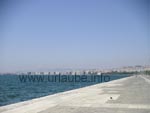
After we followed from the White Tower the Nikis street for approximately two kilometres, we parked the Hyundai somewhere at a side-strip with some other national cars. Thus, we fully trusted the hypothetical probability that at least the owners of the other cars knew what they do. However, we were not completely sure if they really were parking spaces. Then we walked to the centre. Already by leaving the car we noticed that it was hotter than we expected. Around noon time, the greeks that live in big cities prefer to stay in the restaurants and bars that are air-conditioned with temperatures of the north pole, but surely not a walk on the boradwalk that is deserted and free of shades with a length of many kilometres, on which we suddenly were.
But the direction of our march was clearly defined. Somewhere in a distance that we could not estimate, the White Tower wormed its way through the block buildings of the seventies that framed the footpath and rather reminded on the Rhur-University in Bochum than on a southern European big city. In the 15th century, the tower was build by the Turks as a corner tower of the harbour fortification, of which it is the last existing part. In the course of the time, it was used as a deposit of weapons and as a jail, whereas in the second world war, it served the germans as a deposit for food. "This tower is greatly put into scene", we joked from a distance, but the picture cheated a little, as the tower, adorned with a green "belt", really got the space assigned that it derserves as a landmark.
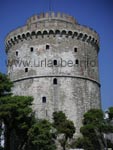
However, the panorama that was offered to us on the way to the tower did not leave anything to be desired. Well, a cool drink wouldn't have been bad. While our organisms were slowly getting hot with 40 degrees in the sun, we could at least have a view to the big in industrial harbour of Saloniki that has a nationwide significance, and to the impressive container vessels in front of the coast.
At the side that is turned away from the sea, at the very top on a hill, the Akropolis of the city is enthroned with a citadel at the highest point , and also the futuristic seeming tv tower, that transmitted the first statutorial greek television in the year of 1966, is widely visible. We finally reached the White Tower, soaked with sweat, and had to realize that a visit of the interior was not possible due to some construction works.
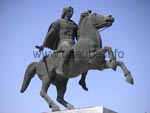
Otherwise, we could have espied from the top, with a good view, the highest mountain of Greece that is 2918 metres high and was at a distance of 80 kilometres, the Olymp. Additionally, it is said that from this Tower with a height of 30 metres, one has a great view over the urban area of Saloniki. At least we could gaze at the impressive statue of Alexander the Great, that is located very closely to the statutorial theatre, so that the march was not completely for nothing.
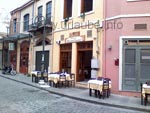
Meanwhile, the public transport network of Saloniki is limited to bus lines and taxis; but both variants are very cheap (bus: 50 cent per direction within the city; taxi: about 1 € per kilometre). Also the trip outside the city is possible with the same means of transportation at a cheap price. Additionally, there are some train lines that cover wide areas of the country. The rail net is indeed not as dense as ours in Germany, but the transport is fast and also not expensive. The completion of the inner-city subway line with 13 stations is planned for 2013. In the daytime, the ferries and the "Flying Dolphin" catamarans cast off, that connect the mainland with, for example, the Aegean island world.
However, our way did not lead us out into the sea, but further into the city. After a long extended break in an air-conditioned restaurant in which I had the Fanta of my life, we decided to continue on foot alongside the boardwalk of the harbour to the harbour district Ladadika with its narrow alleys, cosy cafés, bars and clubs. For those who want to try the night life of Saloniki, this restored and variegated district is highly recommended, as in the evenings and in the week-ends it swarms with people that only want one thing: to look and to be seen. Those who are "in" in Saloniki, come to this place, a thing that is, unfortunately, also noticeable in the higher prices.
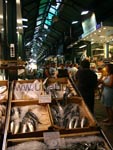
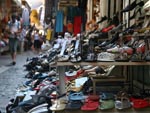
On a thursday afternoon however, there is nothing going and this is the reason why we, after a short sightseeing tour, loafed back to the market district Vatikioti, that is only at a few hundred metres distance at the other side of the Politechniou Tsimiski. Here, there are under the open-air in the big old market hall as the old Modiano market hall beside food as fresh fish, meet, fruit and vegetables also lots of handcrafts, clothes and souvenirs. Here, the turbulence of the big city is far away; instead, there is a coltish market atmosphere, all goods are garished and nicely arranged for the customer's eye, and again, the little taverns invite to stay there for a while.
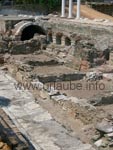
As it does not really make sense to walk around with fresh fish or vegetables with a temperature of 40 degrees, and also, a handmade table is not the ideal luggage for a sightseeing, we soon crossed the highly driven Via Egnatia and arrived to the Forum Romanum that is framed by slab-constructions at the Platia Diskastirion, that was built in the second century and not discovered until the 20th century during a demolishment.
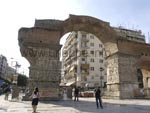
On a surface of two hectares, it offers an insight in some catacombs that partly are well conserved as achways and ruins that at that time were used as shopping malls. It is clear that this is the way the antecessors of out modern shopping malls must have looked like. Also, a little amphitheatre belongs to the whole complex that these days is used as an arena for theatre pieces and concerts. At this historical place, a mixture of styles was presented to us that is typical for Saloniki and its downtown: antique and antiquated buildings mix up with the modern arquitecture and partly make a sharp contrast.
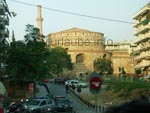
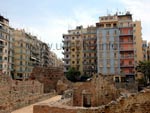
Due to the trapped heat in the street canyons, we started to realize why nearly nobody except us visited the sightseeings of this city at that time. This impression became stronger as we visited the further monuments of the Unterstadt that we approached after a quarter of hour on foot on the Filippou-street. The Rotonda, a three-floor brick building of the 4th century with the last remaining minaret of the city that originally was built as mausoleum for the emperor Galerius, but later used as church and from the late 16th century as a mosque, is connected by a further "green belt" with the Arc of Galerius of the year 306, that once overdrew the Via Egnatia and marked the entrance to the complex of the emperor's residence.
The Oktogon, the stately relicts of the roman emperor's palace, are located a little further to the south, between Via Egnatia and Politechniou Tsimiki. Also, its impressive ruin is also circled by unpleasant high-rise buildings. All buildings are located in the lively pedestrian area Odos Gounari, so that the cultural programm can be easily lightened up. Numerous museums (Atatürk-museum, Design-Museum, film-museum, museum of the prehistorical antiquities and many more) and theatres (state theatre, royal theatre and others) complete the cultural offer in the Unterstadt of Saloniki, but unfortunately, we did not have any time for a visit, as we still did have some great destinations to arrive to.
City tour: old town and Akropolis
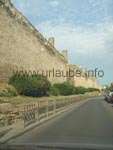
Thus from the Via Egnatia, we took a taxi and drove up to the old town. We could have also have taken the bus line number 23 from the Platia Eleftherias, but as it is enough to position oneself in a good visible place on the street and wave, we took the opportunity to take a taxi again for little money. In Saloniki there are so many taxis on the way, that it only takes a couple of minutes to be collected by one. So it was in our case. The taxi driver rapidly noticed that we are germans and told us on the way, that he has also lived in Germany for a couple of years. So it was not surprising that he, as many other greeks also with who we already got in touch, could speak rather good german.
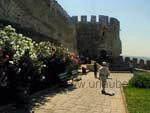
In the upper part of the old town, that went up to the byzantic fortification wall, we left the air-conditioned vehicle and accessed through one of two gates the Akropolis with its citadel of ten towers. Up to the year 1989, a part of this building was still used as a prison, but today it is, after a copious restoration, only a prison museum with interesting insights into the past. From the Trigonios-Tower, a parat of the city wall, a gorgeos view was offered over the roofs of the city and the Thermaic Gulf. Also the tourists appearance was in a nice way much higher than in the other stations. If the reason for this was that the air there was less sticky and waste-gas containing, or because the old town and the Akropolis was simply nicer to look at as the downtown, is not unprobable. But it was surely not cooler up there.
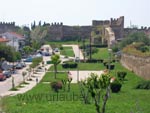
A walk alongside the city wall and through the Akropolis is a real experience, as one has nearly the feeling that one moves through a painting. Indeed, the Akropolis is not an antique place with ruins like elsewhere, but a particular living quarter that is framed by the old walls at the highest city location, with some parts that remind on a well maintained parking complex, but the traces of the antiquity are omnipresent. The whole areal is covered with vegetaded walls und wall relicts, that here also make a contrast to the modern residence buildings. But at the Akropolis, this contrast is really well done .
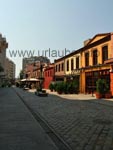
The same is also true for the old town, that we went through afterwards back to downtown. At each corner there is something to discover, as many houses are old, small, antiquated, colourful and built in the typical Macedonian style. The streets of the upper part are very narrow, steepy and labyrinthine, what gives the old town a special rural character. Furthermore, the are some little and bigger churches to find, as the Agios Nikolaos Orphanos of the year 1310 amidst an exuberantly grown garden, adorned by the frescos of the 14th century that are nearly completetly conserved, the Profitis Ilias, the Agia Ekaterini and the Agii Apostoli, as also the monastery Moni Vlatadon, at approximately 150 above the sea and close to the city wall, that was founded in the 14th century and completely restored in the past.
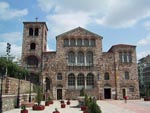
We finally found the most famous building of the old town, the five-naved basilica Agios Dimitrios, in Odos Agiou Dimitriou, that divides the old town and downtown. Again surrounded by industrialized appartment blocks, the monumental light red building of the 5th century captures an area of 35 x 45 netres and offers an impressive forntal view from a place in front of it. The Agios Dimitrios is the biggest church of Greece. In its interior, there is a worth seeing crypt hidden, as also some significant mosaics from the 7th to the 9th century, that belong to the big treasures of the early christian art.
It was only a few metres to the Forum Romanum, so we declared, also because of our physical condition, the tour to be finished. During the last hours, the heat affected us considerably, and I really recommend to everybody to split such a tour, if possible, and to postpone it to the very early hours or the late hours of the day.
So, at the roadside, we again drawed attention to ourselves and after ten minutes, we were collected by a taxi, that took us again to the direction of the harbour boardwalk, passing the exhibition center. Ony a little later, we nearly burst with happyness by the fact that our rented car was still waiting for us at the roadside. On the way back to our little village Paleochori, we lost our way for the last time in a very beautiful district of the city Kalamaria with its palms, the marina, the stylish houses and the busy boardwalk that is approximately 5 kilometres from the city centre, before we left this district behind us and went again in eastern direction to the motorway A2.

Back to the index Saloniki
Copyright: Patrick Wagner, www.tourist-guide.biz
|
 |